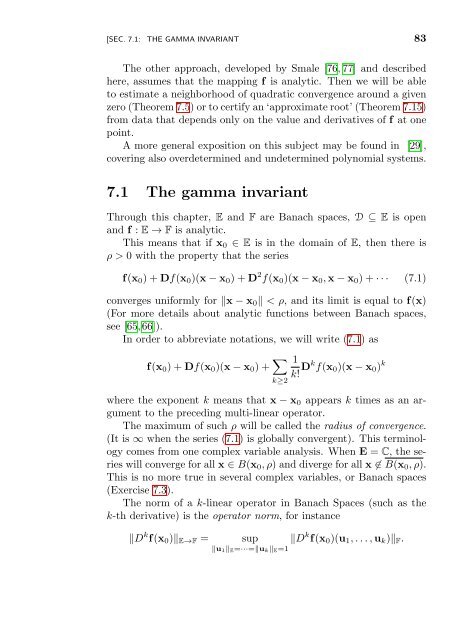Nonlinear Equations - UFRJ
Nonlinear Equations - UFRJ
Nonlinear Equations - UFRJ
Create successful ePaper yourself
Turn your PDF publications into a flip-book with our unique Google optimized e-Paper software.
[SEC. 7.1: THE GAMMA INVARIANT 83<br />
The other approach, developed by Smale [76, 77] and described<br />
here, assumes that the mapping f is analytic. Then we will be able<br />
to estimate a neighborhood of quadratic convergence around a given<br />
zero (Theorem 7.5) or to certify an ‘approximate root’ (Theorem 7.15)<br />
from data that depends only on the value and derivatives of f at one<br />
point.<br />
A more general exposition on this subject may be found in [29],<br />
covering also overdetermined and undetermined polynomial systems.<br />
7.1 The gamma invariant<br />
Through this chapter, E and F are Banach spaces, D ⊆ E is open<br />
and f : E → F is analytic.<br />
This means that if x 0 ∈ E is in the domain of E, then there is<br />
ρ > 0 with the property that the series<br />
f(x 0 ) + Df(x 0 )(x − x 0 ) + D 2 f(x 0 )(x − x 0 , x − x 0 ) + · · · (7.1)<br />
converges uniformly for ‖x − x 0 ‖ < ρ, and its limit is equal to f(x)<br />
(For more details about analytic functions between Banach spaces,<br />
see [65, 66]).<br />
In order to abbreviate notations, we will write (7.1) as<br />
f(x 0 ) + Df(x 0 )(x − x 0 ) + ∑ k≥2<br />
1<br />
k! Dk f(x 0 )(x − x 0 ) k<br />
where the exponent k means that x − x 0 appears k times as an argument<br />
to the preceding multi-linear operator.<br />
The maximum of such ρ will be called the radius of convergence.<br />
(It is ∞ when the series (7.1) is globally convergent). This terminology<br />
comes from one complex variable analysis. When E = C, the series<br />
will converge for all x ∈ B(x 0 , ρ) and diverge for all x ∉ B(x 0 , ρ).<br />
This is no more true in several complex variables, or Banach spaces<br />
(Exercise 7.3).<br />
The norm of a k-linear operator in Banach Spaces (such as the<br />
k-th derivative) is the operator norm, for instance<br />
‖D k f(x 0 )‖ E→F =<br />
sup ‖D k f(x 0 )(u 1 , . . . , u k )‖ F .<br />
‖u 1‖ E =···=‖u k ‖ E =1

















